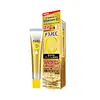What's inside
What's inside
 Key Ingredients
Key Ingredients

 Benefits
Benefits

 Concerns
Concerns

 Ingredients Side-by-side
Ingredients Side-by-side

Aloe Barbadensis Leaf Juice
Skin ConditioningPyrus Malus Juice
Skin ConditioningGlycerin
HumectantCaprylyl Glucoside
CleansingCamellia Sinensis Extract
AntioxidantCucumis Sativus Extract
Skin ConditioningGlycyrrhiza Glabra Root Extract
BleachingTamarindus Indica Seed Polysaccharide
Skin ConditioningHyaluronic Acid
HumectantZanthoxylum Bungeanum Fruit Extract
Skin ConditioningGluconolactone
Skin ConditioningCoconut Alkanes
EmollientOleyl Alcohol
EmollientUbiquinone
AntioxidantDimethylaminoethanol Tartrate
EmollientThioctic Acid
AntioxidantAscorbic Acid
AntioxidantTocopherol
AntioxidantHelianthus Annuus Seed Oil
EmollientCarya Ovata Bark Extract
Skin ConditioningPolyglyceryl-5 Oleate
EmulsifyingSodium Cocoyl Glutamate
CleansingCoco-Caprylate
EmollientSodium Benzoate
MaskingXanthan Gum
EmulsifyingSodium Hydroxide
BufferingCitrus Aurantium Dulcis Oil
MaskingLitsea Cubeba Fruit Oil
MaskingCinnamomum Camphora Wood Oil
MaskingAloe Barbadensis Leaf Juice, Pyrus Malus Juice, Glycerin, Caprylyl Glucoside, Camellia Sinensis Extract, Cucumis Sativus Extract, Glycyrrhiza Glabra Root Extract, Tamarindus Indica Seed Polysaccharide, Hyaluronic Acid, Zanthoxylum Bungeanum Fruit Extract, Gluconolactone, Coconut Alkanes, Oleyl Alcohol, Ubiquinone, Dimethylaminoethanol Tartrate, Thioctic Acid, Ascorbic Acid, Tocopherol, Helianthus Annuus Seed Oil, Carya Ovata Bark Extract, Polyglyceryl-5 Oleate, Sodium Cocoyl Glutamate, Coco-Caprylate, Sodium Benzoate, Xanthan Gum, Sodium Hydroxide, Citrus Aurantium Dulcis Oil, Litsea Cubeba Fruit Oil, Cinnamomum Camphora Wood Oil
Butylene Glycol
HumectantPropanediol
SolventIsopentyldiol
HumectantPropylene Glycol
HumectantPEG-8
HumectantWater
Skin ConditioningAscorbic Acid
AntioxidantAlcohol
AntimicrobialPPG-6-Decyltetradeceth-30
EmulsifyingParfum
MaskingTocopherol
AntioxidantPyridoxine Hcl
Skin ConditioningAllantoin
Skin ConditioningO-Cymen-5-Ol
AntimicrobialAscorbyl Tetraisopalmitate
AntioxidantSodium Metabisulfite
AntioxidantAlpinia Katsumadai Seed Extract
Skin ConditioningDisodium EDTA
3-O-Ethyl Ascorbic Acid
Skin ConditioningAscorbyl Glucoside
AntioxidantSerine
MaskingCitrus Limon Fruit Extract
MaskingCitrus Grandis Fruit Extract
AstringentButylene Glycol, Propanediol, Isopentyldiol, Propylene Glycol, PEG-8, Water, Ascorbic Acid, Alcohol, PPG-6-Decyltetradeceth-30, Parfum, Tocopherol, Pyridoxine Hcl, Allantoin, O-Cymen-5-Ol, Ascorbyl Tetraisopalmitate, Sodium Metabisulfite, Alpinia Katsumadai Seed Extract, Disodium EDTA, 3-O-Ethyl Ascorbic Acid, Ascorbyl Glucoside, Serine, Citrus Limon Fruit Extract, Citrus Grandis Fruit Extract
 Reviews
Reviews

Alternatives
Ingredients Explained
These ingredients are found in both products.
Ingredients higher up in an ingredient list are typically present in a larger amount.
Ascorbic Acid is is pure Vitamin C. This form makes up the largest amount of vitamin C found naturally in our skin.
Not only is vitamin C great for your overall health and immune system, it also has plenty of benefits on your skin.
Vitamin C is best used for brightening skin. It improves dark spots, acne scars, and hyperpigmentation. This is because it blocks the process of skin darkening when exposed to UV.
Remember: Vitamin C should not replace sunscreen!
Your skin uses vitamin C to build collagen. Collagen is one key component in having a strong skin barrier and plump skin. Vitamin C also plays a role in regulating collagen, thus making it effective in improving wrinkles and fine lines.
Ascorbic acid shows potent antioxidant activity. As an antioxidant, it helps fight free-radicals. Free-radicals are molecules that may damage your skin cells. These antioxidants also protect skin against UV damage.
The best formulations include Vitamin E and/or ferulic acid. These two ingredients help stabilize and provide a boost in the benefits of ascorbic acid. This is because ascorbic acid becomes unstable when exposed to UV and air. In fact, you can tell your ascorbic acid has oxidized when it turns an orange-yellow color.
Ascorbic acid is generally compatible with other ingredients. However, using ascorbic acid with other active ingredients might cause irritation. Two ingredients: copper ions and benzoyl peroxide, will inactivate ascorbic acid completely.
Read more about other types of Vitamin C:
Foods rich with vitamin C include oranges, strawberries, broccoli, bell peppers, and more. When consuming Vitamin C, your skin receives a portion of the nutrients.
Learn more about Ascorbic AcidTocopherol (also known as Vitamin E) is a common antioxidant used to help protect the skin from free-radicals and strengthen the skin barrier. It's also fat soluble - this means our skin is great at absorbing it.
Vitamin E also helps keep your natural skin lipids healthy. Your lipid skin barrier naturally consists of lipids, ceramides, and fatty acids. Vitamin E offers extra protection for your skin’s lipid barrier, keeping your skin healthy and nourished.
Another benefit is a bit of UV protection. Vitamin E helps reduce the damage caused by UVB rays. (It should not replace your sunscreen). Combining it with Vitamin C can decrease sunburned cells and hyperpigmentation after UV exposure.
You might have noticed Vitamin E + C often paired together. This is because it is great at stabilizing Vitamin C. Using the two together helps increase the effectiveness of both ingredients.
There are often claims that Vitamin E can reduce/prevent scarring, but these claims haven't been confirmed by scientific research.
Learn more about Tocopherol